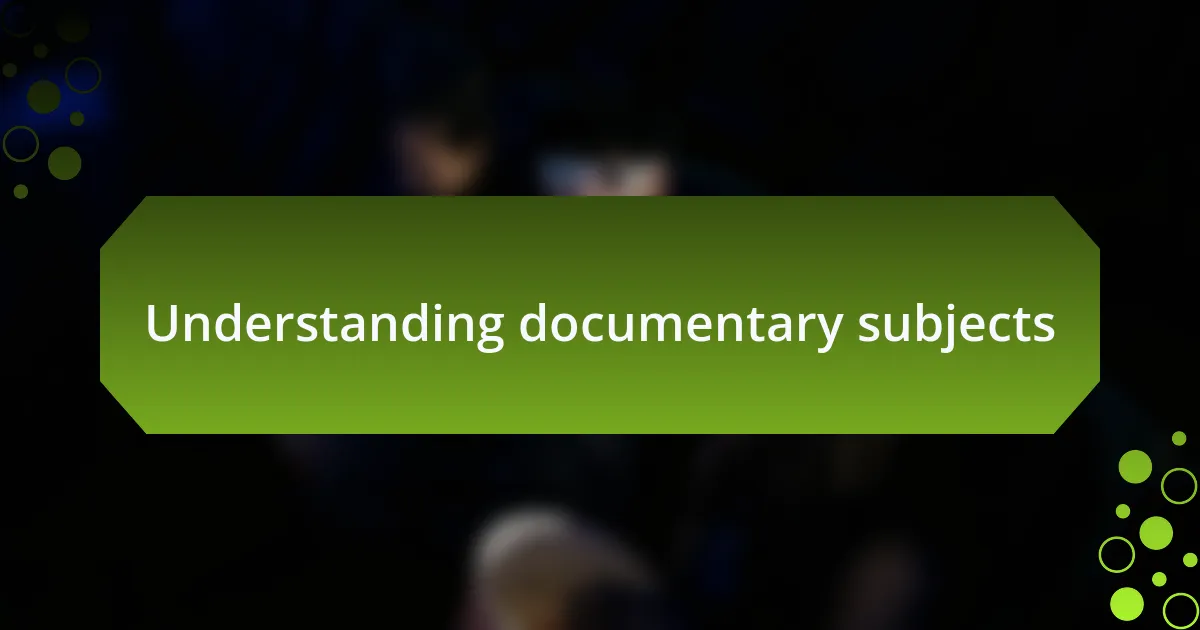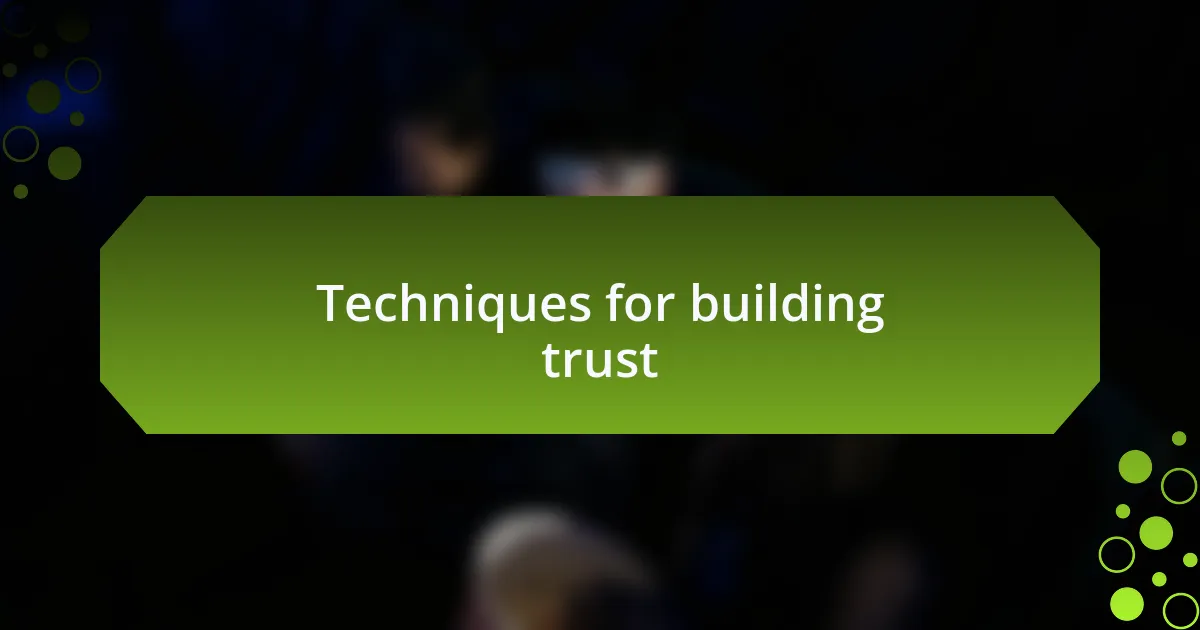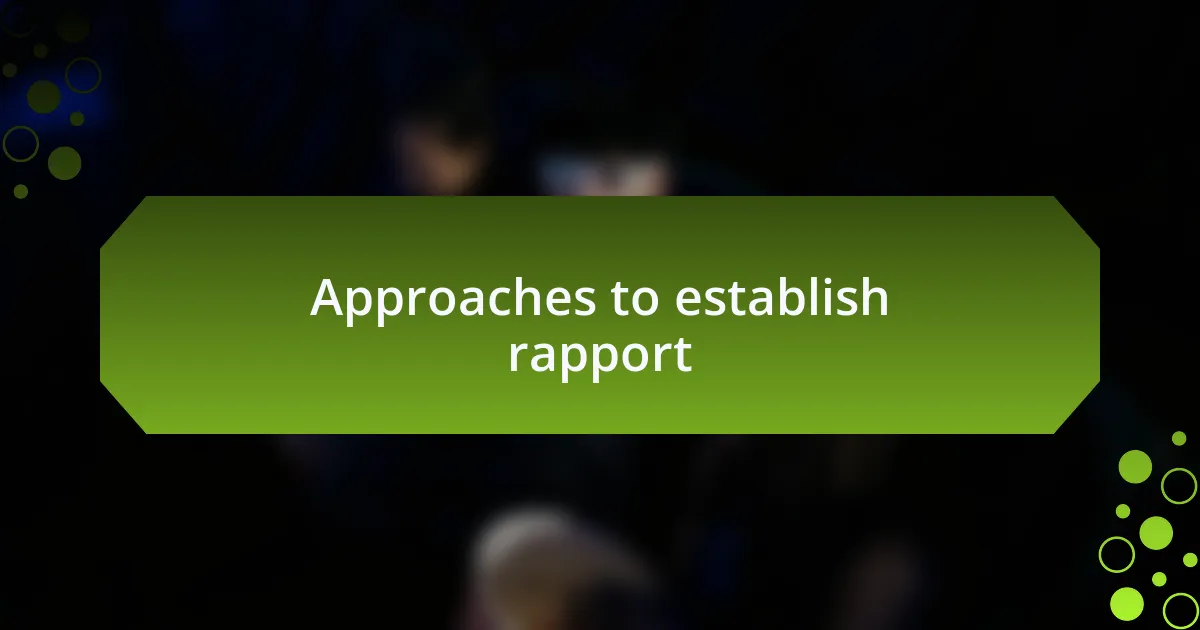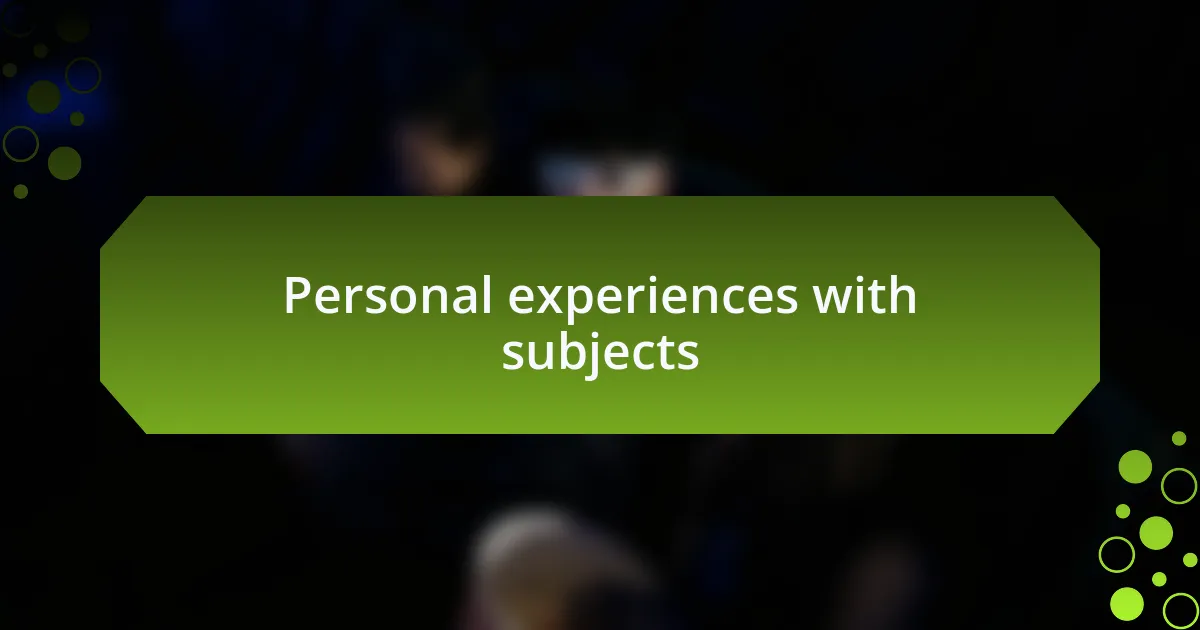Key takeaways:
- Building genuine connections with documentary subjects enhances storytelling, allowing for deeper narratives beyond surface observations.
- Sharing personal stories and practicing active listening fosters trust, encouraging subjects to open up about their experiences.
- Informal engagements and demonstrating genuine interest can transform interviews into meaningful conversations, inviting richer emotional exchanges.
- The impact of connection is profound; moments of vulnerability can lead to powerful storytelling that resonates with audiences more than statistics alone.

Understanding documentary subjects
Understanding documentary subjects requires more than just surface-level observation; it involves digging deep into their lives and experiences. I remember a time when I interviewed a local artist who used paint to express her struggles with mental health. Her vulnerability and passion opened my eyes to the ways personal stories can profoundly impact art and storytelling.
I often ask myself, how can we truly capture the essence of our subjects without stepping into their shoes? This curiosity drives me to engage with them on a personal level, allowing me to form genuine connections. I’ve found that sharing a bit of my own story often invites them to open up in return, creating a dialogue rich with emotion and insight.
When we take the time to understand the backgrounds and motivations of our documentary subjects, we unravel the complexities that make their stories unique. I once spoke with a retired firefighter whose experiences in the line of duty shaped his perspective on community and bravery. His tales were not just about heroism but also reflected his fears and doubts, reminding me that every subject has layers waiting to be explored.

Importance of connection in documentaries
The importance of connection in documentaries cannot be overstated. I recall filming a documentary about a single mother trying to balance work and parenting. While capturing her daily life, I noticed how crucial it was for her to feel understood; our conversations would often lead her to reveal parts of herself that were both raw and inspiring. These moments of authenticity not only made the film more compelling but also illustrated how empathy fosters richer storytelling.
When I engage with documentary subjects, I recognize that each person carries a world of experiences within them. One time, while interviewing a former refugee, he shared his harrowing journey to safety. The emotional weight of his story was palpable, and it struck me that my role as a documentarian is to honor these narratives. Without a genuine connection, these powerful stories might remain untold, confined within the silence of hardship.
Every documentary thrives on the emotional bond between the filmmaker and the subject. I’ve often found that the moments when my subjects let their guard down, like when a musician played a heartfelt song about loss, are where the true story emerges. This connection helps both the viewer and the subject to navigate the complexities of their experiences together, revealing the profound truth behind every individual’s journey.

Techniques for building trust
Establishing trust with documentary subjects is vital, and one technique that has worked for me is sharing personal stories. For instance, during a shoot about addiction, I opened up about my own struggles with motivation. This act of vulnerability not only created a safe space but also encouraged the subject to share their own experiences more openly. It makes me wonder, how much richer would our narratives be if we allowed ourselves to be seen?
Another effective method involves active listening. I remember interviewing an elderly woman about her life during wartime. Instead of interrupting with questions, I simply let her speak, nodding to show understanding. The result was a flow of memories and emotions that added depth to her story. Isn’t it fascinating how silence can often speak louder than words?
Nonverbal cues also play a significant role in building trust. While filming a documentary on community gardens, I made sure to maintain eye contact and mirror the body language of the gardeners. This subtle connection conveyed respect and attentiveness. Have you noticed how genuine engagement can transform a simple conversation into a meaningful exchange? It certainly does in the realm of documentaries.

Approaches to establish rapport
One approach I find particularly effective is spending informal time with my subjects before we even start filming. When I was documenting a local artist, I joined them in their studio for a casual chat about their creative process. This relaxed environment helped break down barriers and allowed for genuine connection. Have you ever noticed how a simple cup of coffee can transform a formal meeting into a friendly exchange?
Another strategy I utilize is demonstrating genuine interest in the person’s story. I vividly recall interviewing a single mother about her journey through financial hardship. Instead of sticking strictly to scheduled questions, I asked about the details of her day-to-day life. Her eyes lit up as she shared anecdotes, and suddenly, the interview felt less like an interrogation and more like a conversation with a friend. Isn’t it amazing how the simplest questions can unlock the deepest emotions?
Lastly, consistency is key in establishing rapport. I’ve learned that returning to revisit subjects, even years later, reinforces trust. For example, after my initial documentary on environmental activism, I checked in with the participants during subsequent events. Each encounter reminded them that their voices mattered, creating a sturdy bridge of trust. How often do we take the time to nurture relationships that have the potential to evolve over time?

Personal experiences with subjects
When I think back on my experiences with documentary subjects, one moment stands out vividly. While filming a documentary about mental health, I spent an afternoon with a young man who bravely shared his struggles. As we talked, I felt a sense of vulnerability wash over both of us. I found myself revealing my own fears and anxieties, transforming our conversation into a shared moment of understanding. Have you ever felt that deep connection that occurs when two people open up to one another?
In another instance, I remember working with a group of refugees and hearing their stories firsthand. One woman recounted her harrowing journey to safety. I could see the emotions flickering across her face—fear, hope, and resilience intertwined. This experience reminded me of the weight our stories carry and how vital it is to honor that. How often do we take the time to listen to those stories that shape our worldviews?
Finally, I’ve realized that humor can be an unexpected tool in building connections. During a project about intergenerational friendships, I chatted with a lively octogenarian who had a knack for storytelling. As he recounted his youthful escapades, laughter filled the air, breaking the tension that often accompanies serious discussions. This light-hearted approach not only made it easier for him to share deeper emotions but also transformed the atmosphere, allowing us to connect on a personal level. Isn’t it fascinating how a little laughter can bridge gaps between generations?

Impact of connection on storytelling
Establishing a genuine connection with documentary subjects profoundly enhances the storytelling process. I recall filming a segment about climate change where I met a farmer deeply affected by shifting weather patterns. As he spoke about the loss of his crops, I felt the weight of his despair, which transformed my approach to the narrative. How can we create a compelling story without truly understanding the human experiences behind the data?
In another instance, during a documentary on addiction, I found myself sharing a quiet moment with a recovering addict. We sat together on a park bench, and as he opened up about his journey, I felt an overwhelming sense of empathy. That moment was pivotal—not only for our relationship but also for how I portrayed his story; it became less about statistics and more about the human spirit’s resilience. Isn’t it incredible how a simple conversation can turn facts into feelings?
Connecting on a personal level often invites deeper truths to surface, reshaping the narrative’s essence. I remember a time while working on a documentary that explored aging, I connected with a woman who had lived through significant historical events. Our discussions illuminated her life lessons in a way that statistics never could. Isn’t it powerful how these personal stories create a tapestry of understanding that resonates with audiences?

Tips for effective communication
Effective communication begins with active listening. I recall a time while interviewing an artist about his work, where I made a conscious effort to listen more than I spoke. This not only encouraged him to share more but also revealed insights into his creative process that I never would have discovered otherwise. How do we truly grasp someone’s story if we’re too busy talking?
Being mindful of body language can greatly enhance your interactions. During a shoot with a group of survivors, I noticed how their expressions changed whenever I leaned in or made eye contact. It created a sense of intimacy and trust, making them feel more comfortable to let their guard down. Have you ever felt how a simple gesture can speak volumes?
Lastly, being authentic and vulnerable in your interactions can break down barriers. In a documentary on mental health, I decided to share my own experiences with anxiety. This openness encouraged my subjects to share their feelings more freely, transforming our relationship. Isn’t it amazing how vulnerability can foster a deeper connection and create a safe space for authentic storytelling?